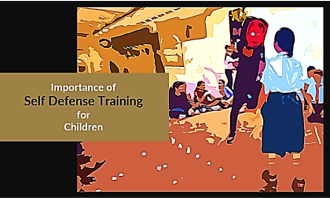
India is home to around 444 million children, one of the largest populations of children and adolescents in the world. Children in India – statistics & facts | Statista. It is very unfortunate but regretfully the crimes against children reported in India are also quite high. According to NCRB statistics, in 2020, maximum child related crimes reported were of abduction and kidnapping (42.6%), followed by POCSO (38.8%) 47,221 cases. Of the total reported child victims under POCSO, 99% were girls between the age group of 12 – 18 years. Violence against Children in India — Vikaspedia.
The statistics on child related crimes reported are reason enough for self defense to be promoted strongly for all children. It is the responsibility of the parents & the schools to ensure that children are taught self defense skills along with other activities that they are involved with in schools. As safety consultants we feel very strongly about the importance of children being given self defense training and have therefore have joined hands with a dedicated self defense training company and will be conducting a 3 day training program for children within their school premises.
It’s important to delve further into the reasons why children should learn self defense, especially in today’s day & time.
Bullying & Abuse
Statistics on a national level for bullying is not available in India however a study conducted in 2019, by The Teacher Foundation, in association with Wipro Applying Thought in School (WATIS) in 15 cities found that around 42% of students from class 4th to 8th and 36% from class 9th to 12th said they were subjected to bullying in school. Violence against Children in India — Vikaspedia
Empowering Children
The primary purpose of self defense training is to empower children by instilling confidence, awareness and the ability to respond to various threatening situations. Some of the reasons why children should learn self defense are listed below:
- Personal Safety: Self-defense equips children with the ability to physically defend themselves if the need arises. While we all hope they never have to use these skills, knowing that they can protect themselves in dangerous situations can give children a significant sense of security.
- Self-Confidence: A distinct advantage of learning self defense is that it boosts the child’s self confidence. A confident child is less likely to be targeted by bullies as there is a level of confidence and self assuredness that comes with knowledge of self defense, this discourages bullies who are generally cowards by nature.
- Improved Awareness: Self-defense training teaches not only about physical safety but alos emphasizes on situational awareness. Children are taught how to recognize threats, diffuse conflicts and make quick decisions when they sense danger. This heightened awareness can help them avoid dangerous situations altogether.
- Effective Communication: Self-defense education goes beyond physical techniques; it teaches children how to communicate assertively and report incidents of abuse or bullying. This is a valuable life skill that can prevent problems before they escalate.
- Discipline and Focus: Self-defense training requires discipline and focus, qualities that can positively influence a child’s overall behavior and performance in school and other activities.
Martial Arts vs. Self-Defense
There is a misconception that if a child is learning a martial art like Karate or Taekwondo he or she would be able to defend themselves in a threatening situation. It’s important to understand the distinction between martial arts which focuses on physical fitness, discipline and the development of skills for sports or self improvement whilst self defense is geared towards practical techniques that can be used in real life situations to protect oneself.
- Objective: The pursuit of martial arts is typically for sport, competition and personal growth. Whilst self defense is primarily about safe guarding oneself in real life circumstances.
- Techniques: Self-defense training prioritizes practical, easy-to-master techniques that can quickly neutralize threats. Conversely, martial arts may involve intricate forms and routines that may not be directly relevant to self-defense.
- Focus: Martial arts training cover a wide curriculum, including sparring and various forms. It focuses on training in its methodologies over a number of years to master the specific martial art. On the other hand self defense focuses on specific skills such as identifying threats, escaping holds, blocking strikes and basic counter attacks.
In essence, while martial arts can offer numerous benefits, they should not be mistaken for comprehensive self-defense training.
Empowering a Safer Future
We delved into the distressing statistics of crimes against children and bullying, it’s evident that children should be equipped to protect themselves both physically and mentally. Empowering children with self defense skills is an investment in their safety and helps them build self confidence. We advocate for children to learn martial arts but it’s necessary to recognize the difference between martial arts and self defense and ensure that children receive appropriate training to deal with real life threats. We are looking to partner with parents and schools in our endeavor to train children in self defense. Our objective is to foster a sense of empowerment and security in each child so they are prepared to face life’s challenges with resilience and confidence. Schools interested in conducting a 3-day self-defense training session or a more comprehensive program are welcome to contact us, at contact@campusfortify.com for further details.
DEC
2023
